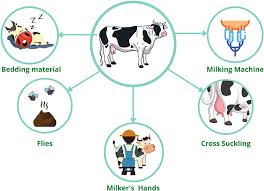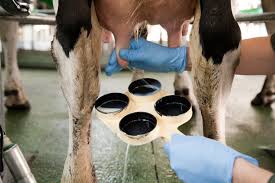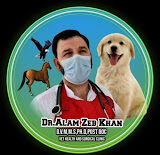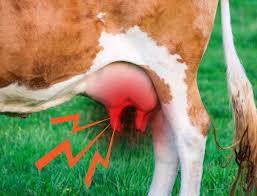Mastitis is one of the most economically significant diseases in the dairy industry. It is an inflammation of the mammary gland, typically caused by bacterial infection. This condition not only affects milk production but also the overall health and welfare of the cow.
Mastitis can be clinical or subclinical. Clinical cases show visible signs, while subclinical mastitis silently damages the udder without outward symptoms, making it more challenging to detect and control.
Etiology: Causes of Mastitis:
Mastitis is primarily caused by pathogenic microorganisms entering the udder through the teat canal. The most common pathogens include:
- Staphylococcus aureus
- Streptococcus agalactiae
- Escherichia coli
- Mycoplasma spp.
- Coagulase-negative staphylococci
Factors contributing to infection:
- Poor milking hygiene
- Teat injuries
- Contaminated bedding
- Improper machine milking
- Weakened immune system

Mastitis can be contagious or environmental, with the latter linked to poor housing conditions and sanitation.
Pathology: How Mastitis Affects the Udder:
Infection triggers the immune system to respond, leading to inflammation of the mammary tissues. This causes:
- Increased somatic cell count (SCC)
- Damage to milk-secreting tissues
- Disruption of alveolar structures
- Decreased milk yield and altered composition
Severe inflammation may lead to abscess formation, fibrosis, and permanent loss of milk-producing capacity in the affected quarters.
Clinical Signs of Mastitis in Dairy Cattle:
Clinical Mastitis
- Swollen, hot, painful udder
- Clots or flakes in milk
- Discolored or watery milk
- Reduced milk yield
- Fever, anorexia, and lethargy in severe cases
Subclinical Mastitis
- No visible signs
- Detected only by elevated SCC or special tests like the California Mastitis Test (CMT)
Cows with subclinical infections act as reservoirs and are critical to identify for effective herd management.
Diagnosis of Mastitis:
Early and accurate diagnosis is vital for effective treatment and control.

1. Clinical Examination
Physical inspection and palpation of the udder and observation of milk.
2. California Mastitis Test (CMT)
A rapid cow-side test to estimate SCC and detect subclinical mastitis.
3. Somatic Cell Count (SCC)
Measured in bulk or individual milk samples. SCC >200,000 cells/mL suggests infection.
4. Bacterial Culture and Sensitivity
Identifies the causative pathogen and guides antibiotic selection.
5. PCR and ELISA
Used in advanced diagnostics for specific pathogens like Mycoplasma.
- For more details Visit:Matitis
Treatment of Mastitis in Cows:
Effective treatment depends on the form and severity of the disease.
1. Antibiotic Therapy
- Intramammary infusion or systemic antibiotics based on culture results.
- Use only under veterinary guidance to avoid antimicrobial resistance.
2. Anti-inflammatory Drugs
NSAIDs reduce pain and inflammation, improving cow comfort and milk production.
3. Supportive Therapy
- Fluids and electrolytes in toxic mastitis cases
- Oxytocin to aid milk let-down
4. Culling
Chronic or non-responsive cases may require culling to protect the herd.
Prevention and Control of Mastitis
Prevention is more economical than treatment. Key strategies include:
1. Hygienic Milking Practices
- Clean teats before and after milking
- Use of individual towels
- Post-milking teat dipping with disinfectants
2. Proper Milking Machine Maintenance
Regular inspection and servicing prevent teat damage and contamination.
3. Dry Cow Therapy
Use of long-acting intramammary antibiotics during the dry period helps clear subclinical infections.
4. Culling Chronic Carriers
Remove cows that continuously spread infection despite treatment.
5. Environmental Management
- Clean, dry bedding
- Ventilation and sanitation of housing areas
- Minimize cow stress
6. Nutrition and Immunity
Balanced diet rich in vitamins and minerals supports udder health and immunity.
- For clinical related case videos of Mastitis CLICK HERE.
Conclusion:
Mastitis in cows is a complex and costly issue that demands a strategic and informed approach. Regular monitoring, good hygiene, prompt treatment, and prevention protocols are essential for maintaining udder health and maximizing milk production. Educating farm staff, working closely with veterinarians, and applying best management practices can significantly reduce the incidence of this disease.
Frequently Asked Questions (FAQs):
-
What is the main cause of mastitis in cows?
Bacterial infections, often from poor milking hygiene or environmental contamination.
-
How can I detect subclinical mastitis?
Through somatic cell count testing or the California Mastitis Test (CMT).
-
Can mastitis be cured?
Yes, with timely and appropriate treatment, most cases respond well. Chronic cases may not.
- For home remedies CLICK HERE
-
Is mastitis contagious?
Yes, contagious pathogens like Staph. aureus and Strep. agalactiae can spread between cows.
-
What is the role of dry cow therapy?
It helps eliminate existing infections and prevents new ones during the dry period.
-
How often should I test for mastitis?
Routine SCC and CMT should be performed monthly or during suspicious drops in milk yield.
-
Can mastitis affect milk quality?
Yes. It alters taste, reduces shelf life, and increases somatic cell count, leading to penalties.
For Pets Related Info:Click Here


